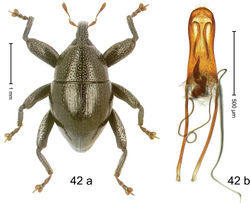Trigonopterus kanawiorum
| Notice: | This page is derived from the original publication listed below, whose author(s) should always be credited. Further contributors may edit and improve the content of this page and, consequently, need to be credited as well (see page history). Any assessment of factual correctness requires a careful review of the original article as well as of subsequent contributions.
If you are uncertain whether your planned contribution is correct or not, we suggest that you use the associated discussion page instead of editing the page directly. This page should be cited as follows (rationale):
Citation formats to copy and paste
BibTeX: @article{Riedel2013ZooKeys280, RIS/ Endnote: TY - JOUR Wikipedia/ Citizendium: <ref name="Riedel2013ZooKeys280">{{Citation See also the citation download page at the journal. |
Ordo: Coleoptera
Familia: Curculionidae
Genus: Trigonopterus
Name
Trigonopterus kanawiorum Riedel sp. n. – Wikispecies link – ZooBank link – Pensoft Profile
Diagnostic description
Holotype, male (Fig. 42a). Length 2.68 mm. Color black; antenna and tarsi ferruginous. Body ovate; in dorsal aspect with weak constriction between pronotum and elytron; in profile evenly convex. Rostrum dorsally with median ridge and pair of submedian ridges, furrows with sparse rows of yellowish scales; in apical 1/3 weakly punctate-rugose. Pronotum densely punctate. Elytra densely punctate with minute punctures, especially on intervals; strial punctures slightly larger; striae impressed as fine lines; lateral stria behind humeri simple, not deepened. Femora edentate. Mesofemur and metafemur dorsally densely squamose with silvery scales. Metafemur with denticulate dorsoposterior edge; subapically with stridulatory patch. Metatibia apically with uncus, without premucro. Abdominal ventrite 5 tomentose. Aedeagus (Fig. 42b) symmetrical; apex subangulate, sparsely setose; body at middle slightly constricted; transfer-apparatus asymmetrical, spiniform; ductus ejaculatorius with bulbus. Intraspecific variation. Length 2.45–2.76 mm. Female rostrum dorsally in apical half flattened, subglabrous, with submedian rows of small punctures. Female abdominal ventrite 5 with sparse recumbent scales.
Material examined
Holotype (SMNK): ARC1133 (EMBL # HE615762), PAPUA NEW GUINEA, Simbu Prov., Karimui Dist., Haia, Supa, S06°40.078', E145°03.207' to S06°39.609', E145°03.012', 1220–1450 m, 02-X-2009. Paratypes (NAIC, SMNK, ZSM): PAPUA NEW GUINEA, Simbu Prov.: 8 exx, ARC1134 (EMBL # HE615763), same data as holotype; 2 exx, ARC1149 (EMBL # HE615777), ARC1150 (EMBL # HE615778), Haia, Supa, S06°40.047', E145°03.464' to S06°40.078', E145°03.207', 1075–1220 m, 02-X-2009; 7 exx, Haia, Supa station, S06°39.905', E145°03.880' to S06°39.796', E145°03.873', 1220–1320 m, 01-X-2009, beaten; 1 ex, ARC1142 (EMBL # HE615770), Haia, Supa, S06°40.047', E145°03.464' to S06°39.815', E145°03.169', 1075–1240 m, 30-IX-2009; 24 exx, ARC1168 (EMBL # HE615796), Haia, S06°41.216', E145°00.945' to S06°40.976', E145°00.979', 970–1135 m, 04-X-2009; 1 ex, ARC1083 (EMBL # HE615714), Haia, S06°41.553', E145°00.355' to S06°41.624', E145°00.728', 800–960 m, 25-IX-2009; 9 exx, Haia, S06°41.259', E145°00.822' to S06°41.102', E145°00.979', 900–1005 m, 27-IX-2009; 4 exx, Haia, S06°41.102', E145°00.979', 1005–1020 m, 27-IX-2009, beaten, “Mimikry-sample”; 10 exx, Haia, S06°41.102', E145°00.979' to S06°40.976', E145°00.979', 1020–1135m, 27-IX-2009, beaten.
Distribution
Simbu Prov. (Haia). Elevation: 960–1220 m.
Biology
Collected by beating foliage in primary forest.
Etymology
This species is dedicated to the people of Papua New Guinea. The epithet is based on the family name Kanawi, found on page 236 of the Papua New Guinea Telephone Directory of 2010 and treated in genitive plural.
Notes
Trigonopterus kanawiorum Riedel, sp. n. was coded as “Trigonopterus sp. 209” by Tänzler et al. (2012)[1].
Original Description
- Riedel, A; Sagata, K; Surbakti, S; Rene Tänzler, ; Michael Balke, ; 2013: One hundred and one new species of Trigonopterus weevils from New Guinea ZooKeys, 280: 1-150. doi
Other References
- ↑ Tänzler R, Sagata K, Surbakti S, Balke M, Riedel A (2012) DNA barcoding for community ecology - how to tackle a hyperdiverse, mostly undescribed Melanesian fauna. PLoS ONE 7 (1): e28832. doi: 10.1371/journal.pone.0028832
Images
|
